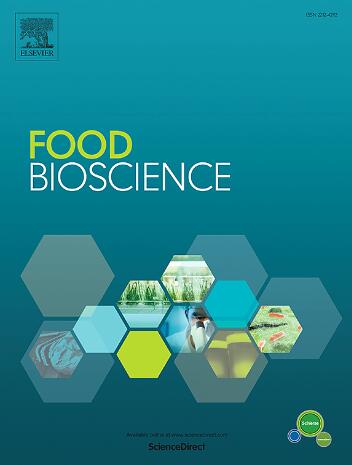Effect of NaCl on gel mechanical behavior of bovine serum albumin–soy protein blends
IF 4.8
1区 农林科学
Q1 FOOD SCIENCE & TECHNOLOGY
引用次数: 0
Abstract
Soy protein gels are widely used in the food industry but have weak structures, even at high concentrations, limiting their functionality. This study explored how blending bovine serum albumin (BSA) with soy protein isolate (SPI) at different ratios and NaCl concentrations affects rheology, mechanical properties, water-holding capacity (WHC), and microstructure. Protein profile and particle size analyses revealed that moderate NaCl concentrations (50 mM) enhanced protein aggregation by reducing electrostatic repulsion and exposing reactive sites essential for gel network formation. Textural analysis confirmed that BSA-dominant gels exhibited higher hardness, springiness, and chewiness, whereas SPI-dominant gels formed weaker networks. At a 7:3 BSA: SPI ratio with 50 mM NaCl, gel hardness increased 1.4-fold higher than the no-NaCl control, reaching a peak of 5142 g. However, increasing NaCl to 100 mM caused over-aggregation and structural heterogeneity, reducing WHC by 8 % (from 95.2 % to 87.3 %) in pure BSA gels. The sample structure with 7:3 BSA: SPI ratio and 100 mM NaCl maintained its strength and consistency, with the storage modulus (G') increasing 1.3-fold compared to BSA-only gels. This treatment achieved an optimal balance of protein interactions, network stability, and textural properties. Intermolecular force disruption experiments demonstrated that disulfide bonds and hydrophobic interactions dominated BSA-rich gels. In contrast, hydrogen bonding and electrostatic interactions played a more significant role in SPI-rich gels. These findings indicate that optimizing BSA: SPI ratios and NaCl concentrations can be applied to achieve the desirable gel texture, strength, and moisture retention, which can be used in developing tailored protein-based food systems.

NaCl对牛血清白蛋白-大豆蛋白共混物凝胶力学行为的影响
大豆蛋白凝胶广泛应用于食品工业,但即使在高浓度下,其结构也很薄弱,限制了其功能。研究了牛血清白蛋白(BSA)与大豆分离蛋白(SPI)以不同比例和NaCl浓度混合对其流变学、力学性能、持水性(WHC)和微观结构的影响。蛋白质谱和粒径分析表明,中等NaCl浓度(50 mM)通过减少静电斥力和暴露凝胶网络形成所需的反应位点来增强蛋白质聚集。结构分析证实,bsa为主的凝胶具有更高的硬度、弹性和咀嚼性,而spi为主的凝胶形成较弱的网络。当BSA: SPI比为7:3,NaCl浓度为50 mM时,凝胶硬度比无NaCl对照提高1.4倍,达到5142 g的峰值。然而,当NaCl浓度增加到100 mM时,会引起过聚集和结构非均质性,使纯BSA凝胶的WHC降低8%(从95.2%降至87.3%)。当BSA: SPI比为7:3时,在100 mM NaCl条件下,样品结构保持了强度和一致性,其储存模量(G′)比仅含BSA的凝胶提高了1.3倍。这种处理方法实现了蛋白质相互作用、网络稳定性和结构特性的最佳平衡。分子间力破坏实验表明,二硫键和疏水相互作用主导了富bsa凝胶。相比之下,氢键和静电相互作用在富spi凝胶中起着更重要的作用。这些发现表明,优化BSA: SPI比和NaCl浓度可以获得理想的凝胶质地、强度和保湿性,这可以用于开发定制的蛋白质食品系统。
本文章由计算机程序翻译,如有差异,请以英文原文为准。
求助全文
约1分钟内获得全文
求助全文
来源期刊

Food Bioscience
Biochemistry, Genetics and Molecular Biology-Biochemistry
CiteScore
6.40
自引率
5.80%
发文量
671
审稿时长
27 days
期刊介绍:
Food Bioscience is a peer-reviewed journal that aims to provide a forum for recent developments in the field of bio-related food research. The journal focuses on both fundamental and applied research worldwide, with special attention to ethnic and cultural aspects of food bioresearch.
 求助内容:
求助内容: 应助结果提醒方式:
应助结果提醒方式:


